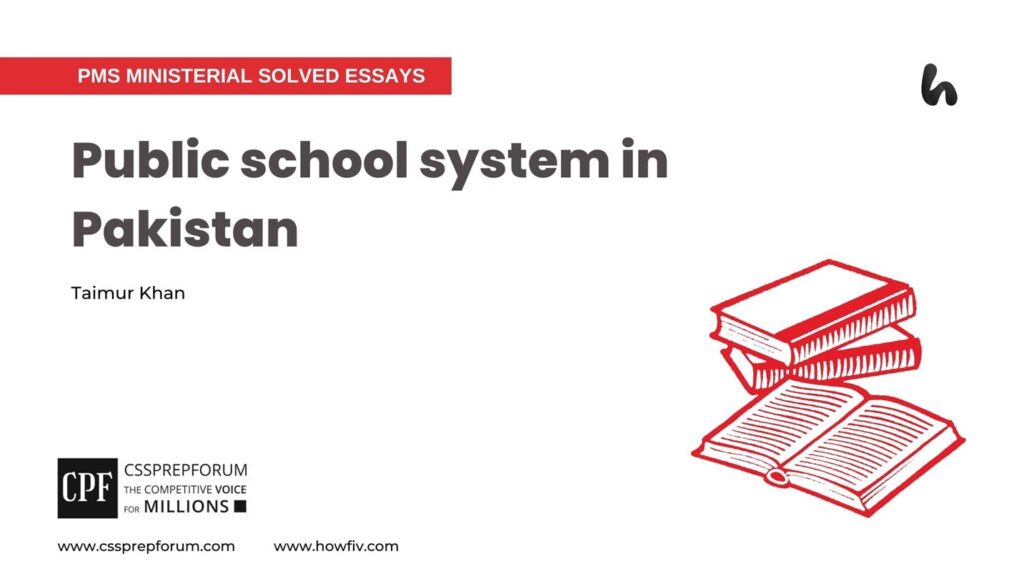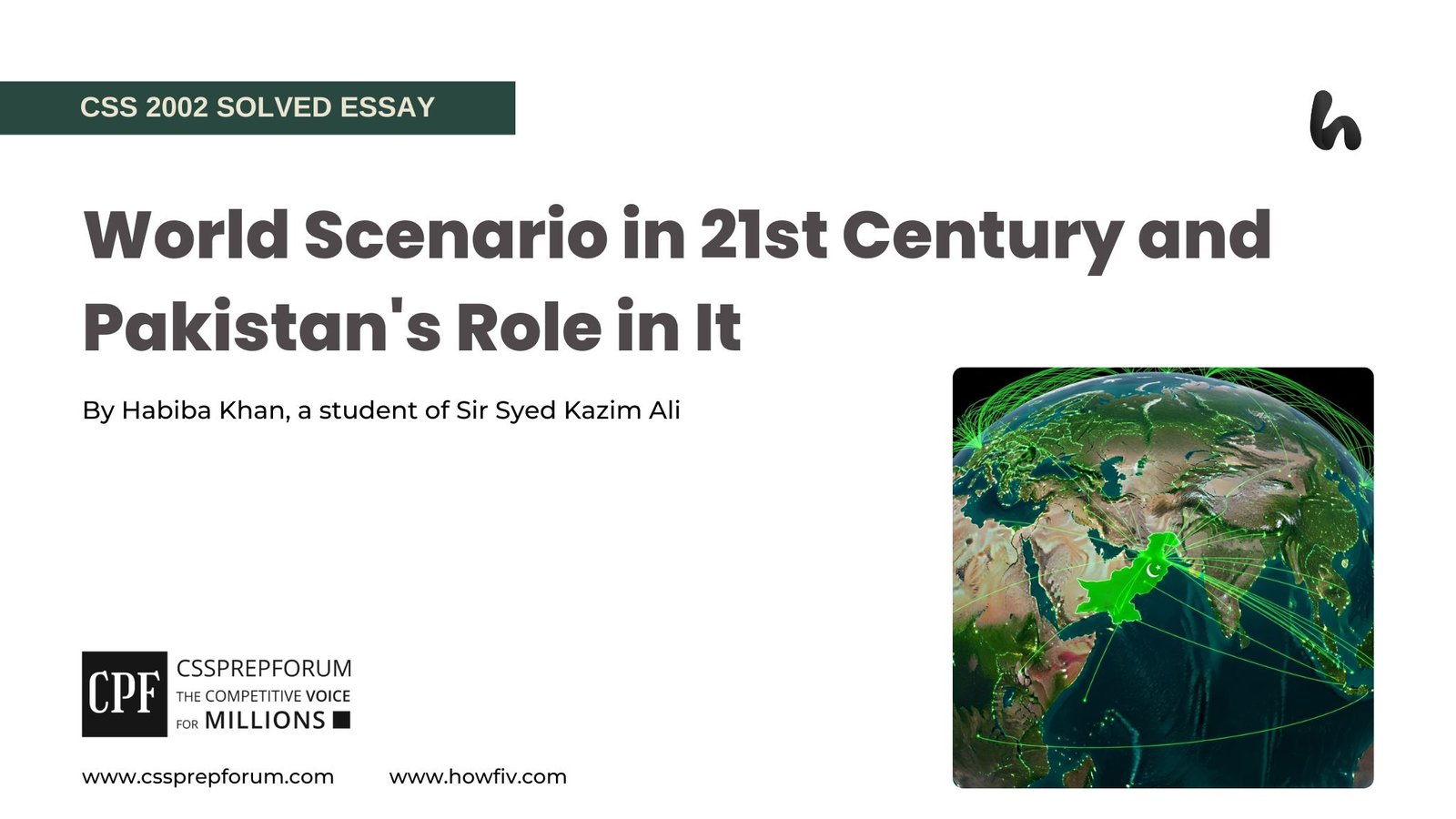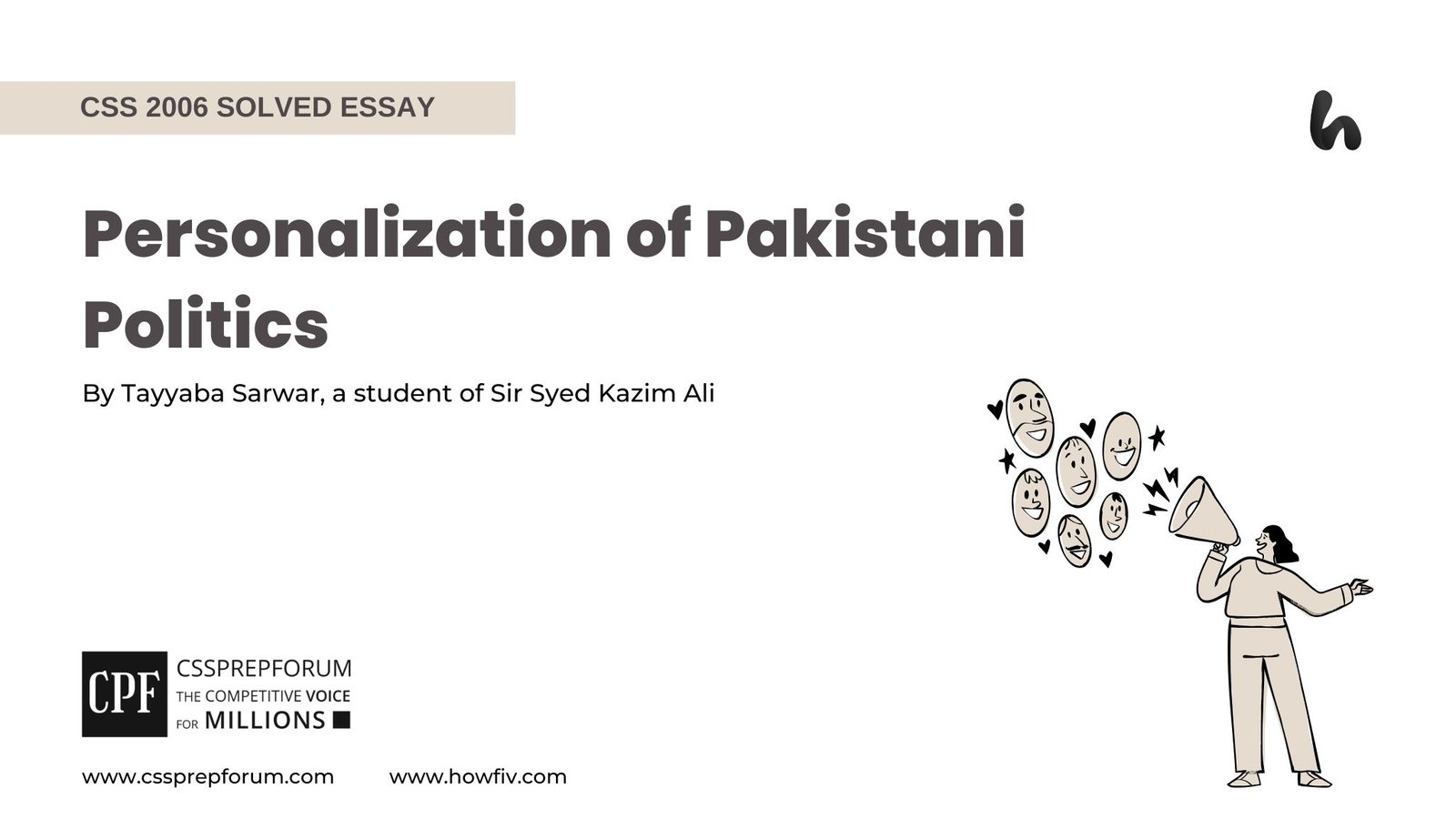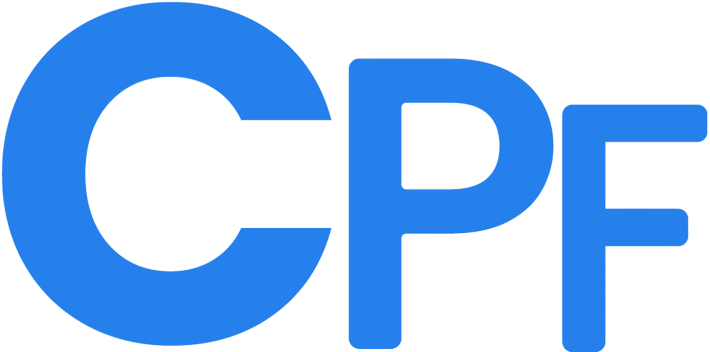PMS Ministerial Solved Essays | Public school system in Pakistan
This PMS Ministerial essay “Public School System in Pakistan” is attempted by Taimur Khan on the given pattern, which Sir Syed Kazim Ali teaches to his students, who have consistently been qualifying their CSS, and PMS essays. Sir Syed Kazim Ali has been Pakistan’s top English writing and CSS, PMS essay and precis coach with the highest success rate of his students. The essay is uploaded to help other competitive aspirants learn and practice essay writing techniques and patterns.
How To Attempt 25-Marks PMS Ministerial Essay?
Most aspirants think a PMS Ministerial Essay is just a shorter version of a CSS or PMS essay; but the truth is, its structure, scoring logic, and examiner expectations are very different. In fact, in just 80–100 words, your introduction alone can decide whether you pass or fail. The outline you write, the way you frame your thesis statement, and the precision of your arguments in body paragraphs all combine to make or break your score.
If you want to see solved PMS Ministerial Essays from top scorers, learn the exact format Sir Syed Kazim Ali teaches his students, and uncover the step-by-step approach that officers themselves used to qualify, click the links below before you try to attempt an essay by yourself.

Public School System in Pakistan
Outline
Introduction
Pakistan’s public school system can become a driver of social mobility and national development if it overcomes chronic underfunding and quality gaps while leveraging its wide reach and potential for human capital growth through comprehensive reforms.
Understanding the Role of the Public School System
- Provides free or affordable education to millions, particularly in rural and low-income areas.
- Acts as the primary means of literacy and basic education in the country.
The key hurdles to an effective public school system in Pakistan
- Inadequate Funding and Infrastructure: Chronic underfunding leaves public schools without basic facilities
Evidence: According to Pakistan Economic Survey (2023), education sector receives less than 2% of GDP, far below the UNESCO-recommended 4–6%. - Quality of Education and Teacher Competence: Outdated teaching methods and lack of teacher training
Evidence: According to the World Bank (2022), Over 40% of Grade 5 students in rural public schools cannot read a simple Urdu story or perform basic arithmetic.
The emerging hopes for the public school system in Pakistan
- Expanding Access to Education: The system’s wide reach offers a unique opportunity to improve literacy and equity if strengthened.
Evidence: Pakistan Bureau of Statistics (2021) — Over 70% of enrolled schoolchildren attend public institutions. - Potential for Human Capital Development: A modernized public school system can create a skilled workforce for economic growth and civic engagement.
Evidence: UNDP (2020) — Countries with stronger public education systems achieve faster growth and stronger democratic institutions.
Suggestion: A Comprehensive Education Reforms
- Reforms in governance, funding, and accountability are essential to bridging the gap between potential and performance.
Conclusion
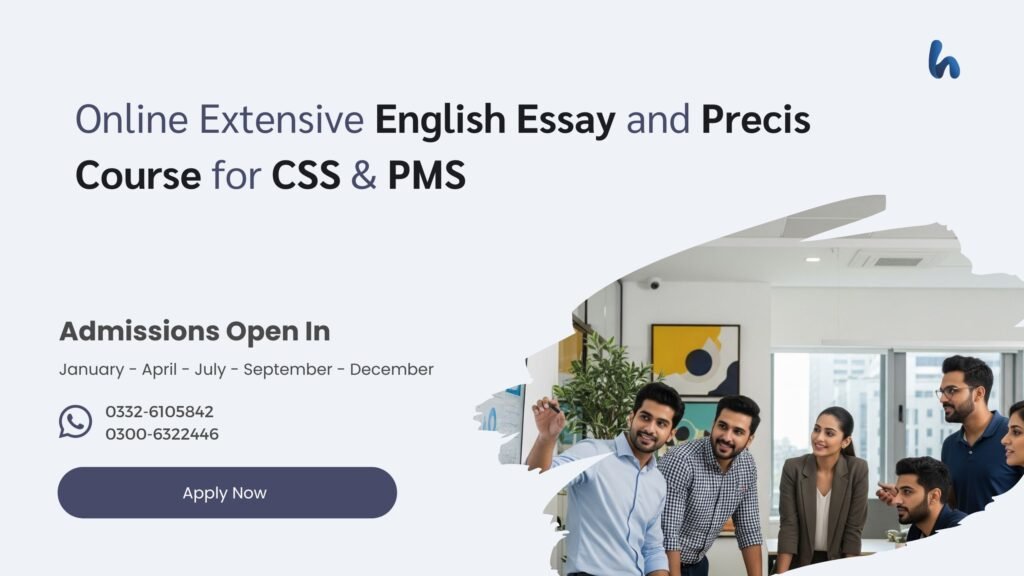
Education is the cornerstone of a nation’s progress, shaping its social fabric and economic potential. Since independence, Pakistan has relied heavily on its public school system to provide learning opportunities to millions of children, particularly in rural and underprivileged areas. However, this vital institution faces persistent challenges that undermine its effectiveness and credibility. Despite these hurdles, the system still holds immense promise for driving literacy, equity, and national development if appropriately reformed. Pakistan’s public school system stands at a crossroads, where addressing issues of funding and quality while leveraging its broad access and potential for human capital development can determine its role in the country’s future. This essay examines the hurdles and hopes of the public school system in Pakistan and proposes actionable reforms for its revitalization.
Before evaluating its hurdles and potential for Pakistan, it is essential to understand the role of the public school system for a country. The public school system refers to state-funded educational institutions that provide free or affordable learning opportunities to children across a nation. In Pakistan, this system serves as the primary channel for basic education, particularly for families in rural areas and low-income urban communities. Its role is vital because it not only imparts literacy and numeracy skills but also promotes social equity by giving all children, regardless of background, the chance to learn. A strong public school network is essential for building a skilled workforce, fostering civic responsibility, and ensuring that economic progress is inclusive and sustainable.
Nevertheless, one of the most serious hurdles facing Pakistan’s public school system is chronic underfunding, which results in poor infrastructure and inadequate learning resources. Many schools lack basic facilities such as clean drinking water, functional toilets, and safe classrooms, creating an environment that discourages attendance and learning. According to the Pakistan Economic Survey (2023), the education sector receives less than 2% of GDP, far below the UNESCO-recommended 4–6%. This underinvestment not only limits the quality of instruction but also perpetuates cycles of illiteracy and poverty in underprivileged regions. Without adequate financial support, the public school system cannot meet the growing educational needs of the population.
Beyond infrastructure, the quality of education in public schools is hampered by outdated teaching methods and insufficient teacher training. Many educators lack the skills needed to deliver engaging, student-centered instruction, relying instead on rote memorization. The World Bank (2022) reports that over 40% of Grade 5 students in rural public schools cannot read a simple Urdu story or solve basic arithmetic problems. This alarming statistic reflects systemic weaknesses in teacher preparation, curriculum design, and classroom monitoring. When students fail to acquire foundational skills during their early years, their future learning potential and employability suffer, deepening the cycle of educational disadvantage.
Despite its shortcomings, the public school system remains Pakistan’s largest educational network, offering an unmatched hope to expand literacy and reduce inequality. For instance, by providing free or low-cost education, it serves as the primary option for millions of children who would otherwise remain out of school. According to the Pakistan Bureau of Statistics (2021), more than 70% of enrolled schoolchildren attend public institutions. This extensive reach means that even modest improvements in quality and facilities could have a transformative impact on national literacy rates. Strengthening this network can ensure that education becomes a universal right rather than a privilege.
Moreover, the public school system also holds the potential to shape Pakistan’s future workforce and contribute directly to national development. A modernized curriculum, combined with skill-based learning, can equip students with the knowledge and abilities required in a competitive global economy. UNDP (2020) notes that countries with robust public education systems experience faster economic growth and stronger democratic institutions. By leveraging its reach to deliver quality education, Pakistan can turn its vast student population into a productive and civically engaged generation. This transformation would not only strengthen the economy but also promote social cohesion and national progress.
To overcome its hurdles and realize its potential, the public school system in Pakistan requires a dual focus on quality enhancement and governance reforms. Increasing education expenditure to at least 4% of GDP, as recommended by UNESCO, would enable the provision of essential facilities, modern teaching materials, and better salaries to attract qualified educators. The SDPI Education Review (2022) found that schools with transparent management structures and performance-based teacher evaluations demonstrated 25% higher student learning outcomes. By combining adequate funding with robust monitoring and accountability, Pakistan can create a public education system that delivers equitable, high-quality learning across all regions.
In conclusion, the public school system in Pakistan embodies both the struggles and aspirations of the nation’s educational journey. Chronic underfunding, poor infrastructure, and inadequate teaching quality continue to limit its potential, yet its vast reach and ability to foster human capital remain powerful assets. With targeted investment, modernized teaching methods, and stronger governance, this system can serve as the backbone of an equitable and prosperous society. The choice before Pakistan is clear: invest in transforming its public education network today, or risk perpetuating cycles of illiteracy and inequality for generations to come.
PMS Ministerial Solved Past Papers’ Essays
Whether you want to learn the art of writing PMS Ministerial Essays or explore solved past papers essays, you’ll find everything you need on the Cssprepforum and Howtests websites.
All essays have been authored by students of Sir Syed Kazim Ali, aspirants who are either essay top scorers or serving officers. In addition, you can access a wealth of guiding articles on essay writing by Sir Kazim, designed to help you develop the skills necessary to write winning essays for competitive exams.
For your convenience, we’ve attached the links below. Click any to start reading and take your preparation to the next level.
| How to Write PMS Ministerial Essay – Complete Format |
| Writing the PMS Ministerial English Essay |
| How to Master PMS Ministerial Essays |
| PMS Ministerial Essays |
| PMS Ministerial Solved Past Papers Essays |
PMS Ministerial Solved Essays
| 1- | Good Governance (2010) |
| 2- | Islam and Brotherhood of Mankind (2010) |
| 3- | Literature is the Essence of Life (2010) |
| 4- | Role of Responsible Media (2010) |
| 5- | A Bird in Hand is Worth Two in the Bush (2016) |
| 6- | He Who Opens a School Door, Closes a Prison (2016) |
| 7- | Local Government is the Base of a Successful Democratic System (2016) |
| 8- | Clean Environment is Good Environment (2016) |
| 9- | Human Resource Development is a Key to Progress and Prosperity (2019) |
| 10- | High Growth Rate in Population is Adversely Affecting our Economic Progress (2019) |
| 11- | Public School System in Pakistan (2019) |
| 12- | Importance of Preventive Healthcare (2019) |
| 13- | National Integration (2021) |
| 14- | Of All Forms of Servitude, the Intellectual is the Most Degrading. Expand This Statement by Showing its Complete Significance and also Attempt to Justify or Disprove it. (2021) |
| 15- | Advantages and Disadvantage of Facebook (2021) |
| 16- | Single National Curriculum: Prospects and Problems (2021) |
| 17- | Impacts of Globalization on Developing Countries |

